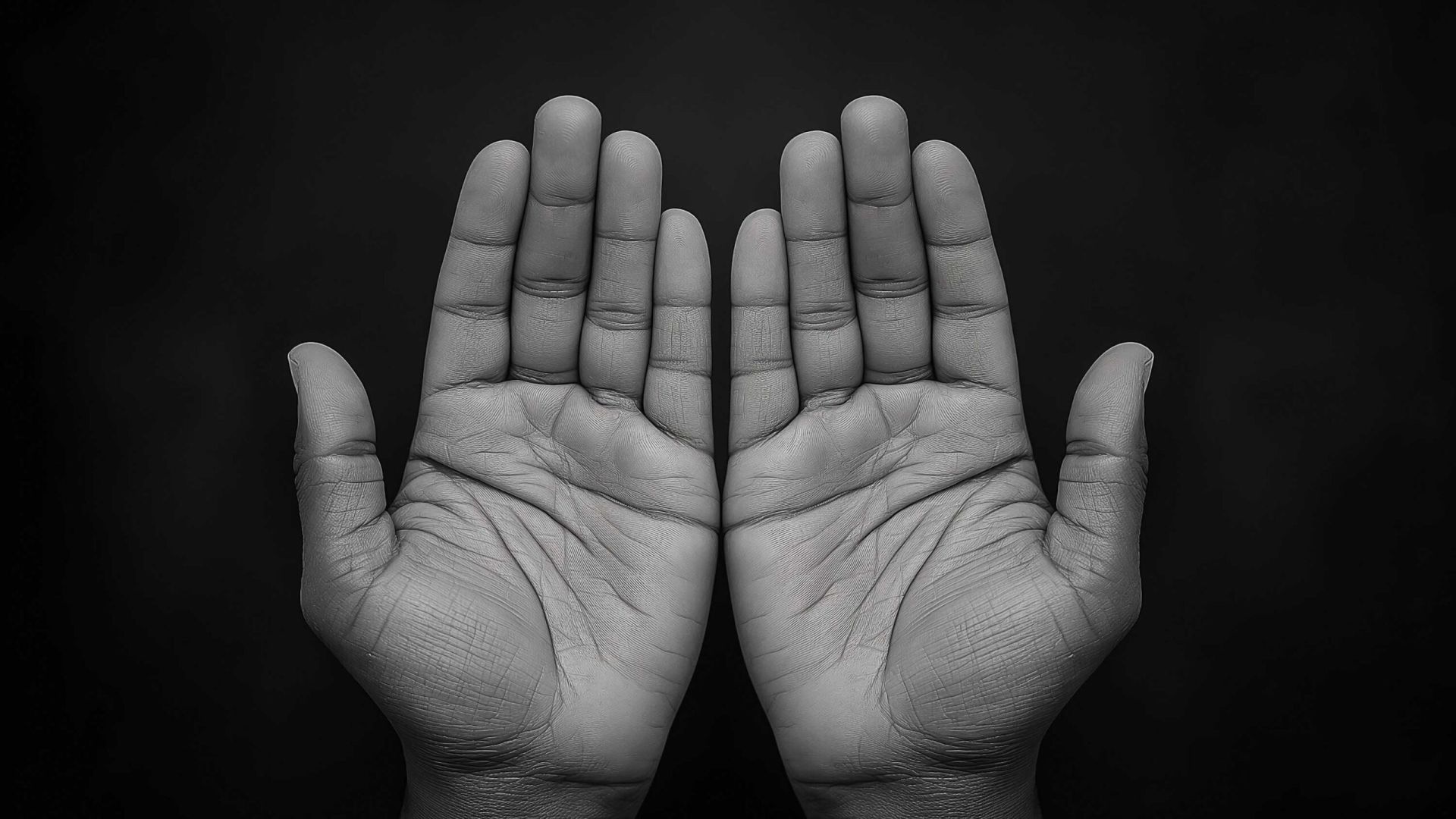Raising the Hands in Ṣalāh (Rafʿ al-Yadayn)
Imām Muḥammad ibn Ṣāliḥ al-ʿUthaymīn


Applicable Positions of Raising the Hands in Ṣalāh and Its Evidence
One should raise their hands while saying the takbīr in ṣalāh. The evidence for this is that raising the hands when saying the takbīr was narrated in several aḥādīth from the Sunnah. Among them is the ḥadīth of Ibn ʿUmar (رضي الله عنهما): “The Prophet (صلى الله عليه وسلم) used to raise his hands until they were adjacent to his shoulders. He would do so when beginning the ṣalāh, when saying the takbīr for rukūʿ, and when raising his head from rukūʿ.1 It was also authentically narrated that he (صلى الله عليه وسلم) would raise them upon returning to the standing position after sitting for the first tashahhud.2 These are four positions in which the hands should be raised as narrated in the Sunnah. They should not be raised in any other position in the ṣalāh.
Methodology of Raising the Hands in Ṣalāh
When raising the hands, the fingers should be held close to one another; tightened. Other scholars have also said: They should be splayed. However, the former opinion is more sound as narrated from the Prophet (صلى الله عليه وسلم).
The fingers, when the hand is raised, should also be extended. That is, not made into a fist by touching the tips of the fingers to the palm of the hand. Extending the fingers of the hand when raising it during ṣalāh was narrated in the books of al-Sunan.3
Applicability of Raising the Hands to Both Men and Women
There is also no difference when raising the hands in ṣalāh between men and women. Thus, a woman should raise her hands just as a man does when praying.
[Q]: What is the evidence of this ruling being inclusive of both men and women?
[A]: There is no evidence to prove specificity. The fundamental state of all rulings is that which is applicable to men also applies to women. Similarly, that which applies to women also applies to men provided there is no evidence to prove otherwise. There is no evidence here that would prove that women should not raise their hands in ṣalāh. Rather, all passages narrated with regards to this are general. Also, the Prophet (صلى الله عليه وسلم) said: “Pray as you observe me praying”4 which was a statement that was made to both men and women.
The Wisdom Behind Raising the Hands
[Q]: What is the wisdom behind raising the hands in ṣalāh?
[A]: The wisdom behind this action is simply emulation of the Messenger of Allāh (صلى الله عليه وسلم). In doing so, one may extricate his mind from having to pace back and forth to intellectualise this manner of praying. For this reason, when the Mother of the Believers, ʿĀʾishah (رضي الله عنها) was asked: “Why is it that a menstruating women fulfils the missed days of fasting but not missed prayers?”5 She replied: “We used to ponder the same matter. But, we were ordered to fulfil the missed days of fasting and we were not ordered to perform missed prayers.” Here, she (رضي الله عنها) justified her actions using only an issued order. Enacting the commands narrated in such passages should be the end goal for all believers. As the Most High said:
وَمَا كَانَ لِمُؤْمِنٍ وَلَا مُؤْمِنَةٍ إِذَا قَضَى اللَّهُ وَرَسُولُهُ أَمْرًا أَن يَكُونَ لَهُمُ الْخِيَرَةُ مِنْ أَمْرِهِمْ
“It is not for a believer, man or woman, when Allāh and His Messenger (صلى الله عليه وسلم) have decreed a matter that they should have any option in their decision.”
(Al-Aḥzāb, 33:36)
Such that when it is said to a believer: This is the ruling of Allāh and His Messenger (صلى الله عليه وسلم), his vocational responsibility should only be responding with: We hear and we obey.
Despite this, we may contemplate the commands issued seeking to elucidate wisdom in the actions of the Messenger (صلى الله عليه وسلم). Regarding this, we say: The wisdom in raising the hands is recognition of Allāh’s—the Exalted in Might—greatness such that in a single instance we attest to His magnanimity both verbally and physically, simultaneously worshipping Allāh with both forms. For, indeed, if you were to truly and thoroughly conceptualise the statement “Allāh is the greatest”, you would find yourself completely absent-minded from the contents of this entire worldly life. Allāh is greater than all things and you, now, find yourself standing before the One who is greater than all things. Other scholars have also reasoned that the raising of the hands is meant to signify a form of raising the veil between yourself and Allāh. Normally, a person would remove a veil by raising their hands. Others have postulated a third reason which is that raising the hands represents a means through which one’s ṣalāh is beautified. For if a person was to simply stand and say the takbīr without moving at all, his ṣalāh would not have been performed in an exemplary, completely perfect manner. There is also nothing that would preclude all these reasons from applying to this act.
The Highest Point Reached When Raising the Hands
When raising the hands, the apex of its trajectory should be adjacent to one’s shoulders. That is, he should raise them, stopping when they are adjacent to his shoulders.
Raising the Hands for the Disabled
[Q]: If a person has a disability that prevents him from raising his hands to shoulder-level, what should he do?
[A]: He should raise it as high as he is able, as Allāh—the Most High—said:
فَاتَّقُوا اللَّهَ مَا اسْتَطَعْتُمْ
“So keep your duty to Allāh and fear Him as much as you can.”
(Al-Taghābun, 64:16)
[Q]: Hypothetically, a person has a disability that prevents him from raising his hands to his shoulders or even lower than that. For example, his elbows do not bend or are immobile. Should he still raise his hands?
[A]: He should still try to raise it due to the saying of the Most High: “So keep your duty to Allāh and fear Him as much as you can”. Even if he cannot raise one hand, he should still raise the other as evidenced by this verse. Also, because when the Prophet (صلى الله عليه وسلم) was standing in ʿArafah [during Ḥajj], invoking Allāh with both hands raised and the reigns of his camel fell, he (صلى الله عليه وسلم) retrieved the reigns with one hand and continued invoking Allāh with the other.6
One may also raise his hands until they are adjacent to the tips of his ears as narrated from the Prophet (صلى الله عليه وسلم). Here, raising one’s hands when praying is among the acts of worship that have been narrated in several ways.
The Course of Action in Relation to Acts of Worship With Several Forms
The scholars—may Allāh have mercy on all of them—have differed regarding the acts of worship that have been narrated in several ways. For these actions, is it better for a person to adopt a single form, or enact each one of them alternatively at different times, or combine the different forms into a single act if possible? The correct opinion is the second, moderate view. This is that any act of worship that is narrated in several manners should be done sometimes in one way and at other times in another. For example, it has been narrated that one should raise their hands to their shoulders. It has also been narrated that one should raise them to the tips of their ears. Thus, the best course of action is to enact this method of raising sometimes, and the other one at other times. This facilitates enacting the Sunnah in both ways. In doing so, one keeps the Sunnah alive as enacting one and not the other will result in the death of the abandoned act. The Sunnah cannot remain alive except by enacting both alternatively at different times. Also, when a person enacts one form and then the other, he will find his heart more present when enacting the Sunnah. This is contrary to the state of the one who performs the same act repeatedly like a machine. This is well-observed amongst people. Another example is if people are accustomed to saying the opening duʿā of the ṣalāh:
سبحانك اللهم وبحمدك وتبارك اسمك وتعالى جدك ولا أله غيرك
The one who consistently says this duʿā and none other than it, you will find that as soon as he says the opening takbīr and starts the ṣalāh, he immediately begins saying it without conscious thought. This is because he is in the habit of saying it alone. However, if he was to say this invocation sometimes, and other (legislated) invocations other times, he would find himself more attentive in prayer.7
To summarise, enacting all narrated forms of the particular acts worship that have been narrated with several forms has multiple benefits:
- Following all of the Sunnah.
- Reviving and keeping all of the Sunnah alive.
- Allowing one’s heart to be present when performing acts of worship.
- One form may be shorter than the others—for example, the forms of dhikr after the conclusion of the ṣalāh. Occasionally, a person may need to leave immediately after the ṣalāh. In such circumstances, he may suffice with saying ‘سبحان الله’ ten times, ‘الحمد لله’ ten times, and ‘الله أكبر’ ten times. Here, he would have enacted the Sunnah while also fulfilling his own personal requirements of having to leave as expeditiously as possible. There is nothing wrong with a person engaging in such an act based on a personal need as Allāh—the Most High—said regarding the pilgrims:
لَيْسَ عَلَيْكُمْ جُنَاحٌ أَن تَبْتَغُوا فَضْلًا مِّن رَّبِّكُمْ
“There is no sin on you if you seek the Bounty of your Lord (during pilgrimage by trading, etc.).”
(Al-Baqarah, 2:198)
Commensuration of the Narrations
Other scholars have also said: The hands are raised such that the tips of the fingers are adjacent to the tips of the ears, and the bottom of the hand is across from the shoulders [combining the narrations]. We respond: Such commensuration is not needed. This is because the implied meaning of ‘hand’ is its entirety, not its top or bottom specifically. It is most apparent that there is flexibility in this matter due to the individual characteristics of both manners of raising the hands to be similar to one another.
Raising the Hands in Relation to the Takbīr
The narrations that define when raising the hands should begin also differ from one another. Some narrations indicate a person should raise his hands before saying the takbīr, while others indicate saying the takbīr before raising the hands, and others indicate that one should raise his hands while saying the takbīr. That is, he should start saying the takbīr when he starts raising his hands, finishing the takbīr when he finishes raising his hands, before dropping them. We say: There is also flexibility in this matter. Regardless of whether a person raises his hands then says the takbīr, or says the takbīr before raising his hands, or says the takbīr while raising his hands; a person who enacts any of these methods should be considered as having enacted the Sunnah.
Endnotes:
[1] Authentic: narrated by al-Bukhārī: 739 and Muslim: 390.
[2] Authentic: narrated by al-Bukhārī: 739.
[3] Authentic: narrated by al-Tirmidhī: 240 and graded authentic by Shaykh al-Albānī. See Sunan al-Tirmidhī edited by Aḥmad Shākir.
[4] Authentic: narrated by al-Bukhāri: 631.
[5] Authentic: narrated by al-Bukhārī: 321
[6] Authentic: narrated by al-Nasāʾī: 3011 and graded authentic by Shaykh al-Albānī in Ṣaḥīḥ Sunan al-Nasāʾī: 2817.
[7] Translator note: See the many other opening duʿāʾ as mentioned by Shaykh al-Albānī in Ṣifat al-Ṣalāh 1:240.
Source: Al-Sharḥ al-Mumtiʿ 3: 25-31
Translated by: Riyāḍ al-Kanadī

















